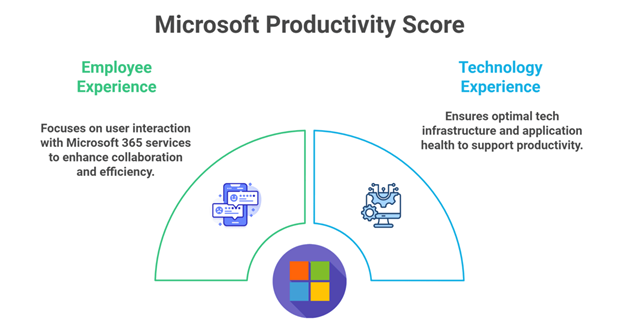Leveraging Microsoft Productivity Score for Enhanced Team Performance
In 2020, Microsoft decided it was time for organizations to have a tool that helps them maximize the benefits of the Microsoft 365 platform. Enter Microsoft Productivity Score, a comprehensive tool designed to help organizations assess and optimize their use of the productivity platform. The tool provides organizations with valuable, and discreet, insights into how effectively teams are adopting and utilizing these applications.
Productivity Score’s main aim is to identify areas requiring major improvement and facilitate targeted actions to enhance productivity. Organizations can use the tool to view and analyze user engagement across applications like Teams, SharePoint, and Outlook, enabling businesses to identify underutilized or misconfigured tools. This input empowers key stakeholders to take targeted remedial actions, such as implementing focused training programs, streamlining processes, and cultivating enhanced collaboration among teams.
This blog will help you familiarize yourself with the Microsoft Productivity Score and why leveraging it leads to improved team dynamics, streamlined operations, and a more agile work environment.
Understanding Microsoft Productivity Score
Microsoft Productivity Score, also known as Adoption Score, is a powerful analytical tool to measure and manage the adoption of Microsoft 365 applications within an organization. It provides insights into employee engagement across various categories, such as communication, teamwork, content collaboration, and mobility. By aggregating data at the organizational level, the Productivity Score empowers IT administrators to make informed decisions about technology investments and training initiatives.
What Microsoft Productivity Score Actually Does?
At its core, Microsoft’s Productivity Score goes beyond mere data collection—it provides actionable insights that organizations can use to enhance productivity and collaboration. Rather than overwhelming IT departments and business leaders with raw data, the tool interprets usage patterns across Microsoft 365 applications, delivering clear and meaningful recommendations for improvement.
Productivity Score tracks how well employees are engaging with tools like Teams, OneDrive, and Outlook, and then breaks down this data into easy-to-digest insights. For example, it might highlight how frequently teams are collaborating through shared documents, holding virtual meetings, or using cloud storage. These insights help organizations spot inefficiencies, such as underutilized collaboration tools or excessive email use, and suggest ways to shift towards more effective practices.
Moreover, Adoption Score offers visibility into how employees are adopting new features or services rolled out within the Microsoft 365 ecosystem. By pinpointing areas where adoption is lagging, businesses can proactively offer training sessions or resources to ensure that employees are making the most of the tools at their disposal.
The actionable insights provided by Microsoft Productivity Score don’t just help improve current processes—they contribute to a continuous cycle of digital transformation. By using data-driven strategies, organizations can evolve their work environments, ensuring that their teams remain agile, productive, and ready to meet future challenges head-on.
Key Categories of Microsoft Productivity Score
If we were to boil down the application to its core functionalities, the Microsoft Productivity Score focuses on two key areas: Employee Experience and Technology Experience. These categories enable organizations to understand how employees interact with these tools and whether they require more training to utilize the tool optimally or whether the technology itself is hindering productivity.
- Employee Experience: As the phrase implies, this category provides insights into how users are interacting with Microsoft 365 services. It can be further categorized as follows:
- Content Collaboration: Tracks how effectively users work together on documents, focusing on file sharing and co-editing in real-time.
- Meetings: Measures how time is spent in meetings and the level of engagement, helping teams identify opportunities for improving meeting efficiency.
- Communication: Analyzes interactions across platforms like Teams and Outlook, showing how often teams are staying connected and exchanging information.
- Teamwork: Evaluates how well employees collaborate in shared environments such as Microsoft Teams, ensuring that teamwork is a seamless experience.
- Mobility: Looks at how users work across devices and locations, assessing whether mobile tools are being leveraged to maintain productivity in flexible working conditions.

- Technology Experience: While technology rarely is the cause of problems and most digital issues can be traced to human error, it is still crucial to ensure that the underlying tech infrastructure is properly configured and optimally functioning. The Technology Experience category highlights potential barriers to productivity that stem from technical inefficiencies. It can be further broken down into the following:
- Microsoft 365 Apps Health: Monitors the health of applications, ensuring that users have the most up-to-date and functional versions of the software.
- Network Connectivity: Assesses the quality of the network connection between users and the cloud services, helping organizations troubleshoot and resolve connectivity issues.
- Endpoint Analytics: Evaluates the performance of users’ devices, identifying issues that could affect overall productivity, such as slow processing speeds or outdated hardware.
Privacy Considerations While Utilizing MS Productivity Score
Privacy concerns remain a top priority with the ever-increasing reliance on digital systems for operations. Looking at the Productivity Score and what it does might leave users believing that their actions are being monitored and even scrutinized on an individual level. However, Microsoft has gone out of its way to assure users that Productivity Score operates at an organizational level and not an individual one. The analytical tool looks at application usage trends across the entire business and cannot track or expose a single employee’s activities or behaviors.
Adoption Score collects aggregate data, all of which is anonymized, providing broad insights into Microsoft 365 performance, health, and usage. Microsoft’s commitment to privacy is further reflected in their updates to the tool, which now avoids displaying any personally identifiable information, ensuring that the insights derived are aimed solely at enhancing organizational performance without infringing on user privacy. This privacy-by-design approach helps build trust while enabling organizations to optimize their digital transformation journey effectively.
Utilizing MS Productivity Score Insights for Digital Transformation
Digital transformation is not just about incorporating the latest technologies to drive operational efficiency; it’s about fundamentally reshaping how an organization operates and delivers value to its customers. The insights gained from Microsoft Productivity Score play a pivotal role in this transformation process. The data obtained from the analytical platform simplifies the identification of gaps and areas for improvement.
These insights enable organizations to tailor their digital applications to meet their specific needs, enhancing both collaboration and efficiency. For example, if the Productivity Score indicates low usage of collaboration tools like Teams or SharePoint, organizations can implement targeted training programs to improve employee proficiency and comfort with these platforms.
Furthermore, the application provides data that guides leadership to strategically invest in resources, ensuring that relevant tools are allocated the required computational resources for maximum operational effectiveness without any wastage. Organizations can continually improve and even foster a dynamic and agile work culture by leveraging these insights from MS Productivity Score. Ultimately, effectively utilizing the Productivity Score not only enables a business to further its profit margins by optimizing application usage and simplifying processes but also enhances the overall employee experience by empowering team members to work more efficiently and collaboratively.
By creating an environment that prioritizes both technological optimization and employee empowerment, organizations can achieve sustainable growth and resilience in an ever-evolving marketplace. In this way, the Microsoft Productivity Score serves as a valuable resource for organizations aiming to balance operational efficiency with a positive workplace culture.
Choose Apps4Rent for an Optimized Microsoft 365 Experience
Apps4Rent is a proud Microsoft Solutions Partner, bringing extensive expertise in all aspects of Microsoft 365 and its tools, including the Microsoft Productivity Score. If you haven’t yet found the ideal licensing solution for your organization, explore our Microsoft 365 plans to experience seamless integration and advanced capabilities, backed by our expert guidance. Connect with our dedicated customer support team today to unlock new opportunities for growth and efficiency, like the ways mentioned in this blog! Let us help you transform your organization into a streamlined powerhouse, empowering your teams to drive success and innovation through informed decision-making with Microsoft Productivity Score.
You can reach us over chat, call, or text to learn more about how we can help streamline your Office 365 experience.



